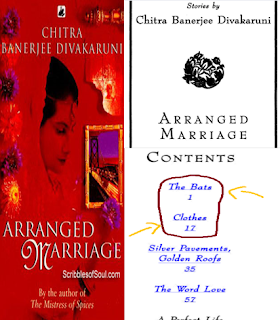Chitra Banerjee Divakaruni’s Arranged Marriage
Blogger: http://desaikaushal1315.blogspot.com
Slideshare: http://www.slideshare.net/kaushal111
Kaushal Desai
kaushaldesai123@gmail.com
Chitra Banerjee Divakaruni’s Arranged Marriage: Feministic issues in her stories, “The Bats” and “Clothes”.
Introduction
The real issues can be conducted with greater effect, here as well the
stories of Chitra Banerjee has lot more to say. Indian American writer Chitra Banerjee Divakaruni is an
award winning and best-selling author, poet, activist and teacher. She writes
the critical disputes of present time. Chitra Banerjee Divakaruni’s Arranged
Marriage, a masterpiece is a collection of short stories. This book
received the 1996 American Book Award, the Josephine Miles Award, The Bay Area
Reviewer’s Award and The Pen Oakland Award. The stories in the collection
provide a representation of Indian women’s experience, their turbulent lives.
The stories in the collection deal with conflicts arising due to man-woman
relationship in the patriarchal society, that again in a land of their
adoption, especially in case of women. So, Divakaruni’s fiction is famous as
the fiction dealing with the immigrant experience. Divakaruni, like her
contemporaries Gita Hariharan, Anita Nair, Meena Alexander, analyses the
pressures and conflicts which women experience or face in a patriarchal frame
of reference. The milieu of Divakaruni’s stories is Kolkata or USA. Divakaruni
seems to employ the form of short story ‘to dramatize the ordeals of wronged
womanhood’.
Arranged Marriage establishes the theme of female
itinerancy that Mistress of Spices and Sister of My Heart will later gather as
well as foregrounds related issues of racism and assimilation into new
societies. Another major thread that connects many of the stories in this collection
is the theme of arranged marriage and its impact on women who usually have very
little say in their matrimonial destiny. The text can be taught at various
scholastic levels and in courses organized around different themes. For
example, Arranged Marriage may be included in classes on American literature,
Asian-American literature, Indian literature, South Asian diaspora literature,
women’s literature, and ethnic literature.
The
Book contains eleven stories. All the stories have women as their focus and
bring out the issues dealing with women, their search for identity,
self-actualization, self-assertion etc. The recurrent theme of the collection
is woman, her various roles and the nuances of these roles. Divakaruni
interrogates the patriarchal system, traditional idea of woman and motherhood.
There seems to be an attempt at demythologizing the very concept of motherhood
in patriarchy. Let us see the first story and find out feministic approach with
make eagle eye on it;
The first story, “The Bats” deals with a
victimized, helpless life of a housewife whose condition is like the bats who
have to return to her uncle’s farm where the only alternative is their death.
The story also brings in the issue of the societal eye and the demeaning status
of women separated from their husbands.
The story is set in Kolkata. A foreman in a printing press, comes home
drunk and regularly beats his wife, but her lack of economic independence makes
her suffer silently without protest. She hides the beating marks and scars from
her daughter. But the daughter states ‘a couple of days later, mother had
another mark on her face even bigger and reddish blue’. However, the wife has
to seek refuge at her uncle’s place when the beating becomes unbearable.
However, she seems to be so conditioned to being with him that she succumbs to
his fake promises. Besides, the consequences of her desertion are also
unbearable for her and she returns to him. Divakaruni uses the interlude of
bats which surround the mango grove but even when their first batch is
poisoned, the next batch does come to the same place. Divakaruni uses bats very
symbolically to bring out the issue of inevitability of the marriage ties in
India. The uncle says:
‘I
guess they don’t realize what’s happening. They don’t realize that by flying
somewhere else they will be safe or maybe they do, but there’s something that
keeps pulling them back here’. (AM, 10).
Both the wife and the bats know that they are not safe
and secure there but it is an inevitable place for them. Divakaruni exposes the
cultural devaluation of women as the object of violence and also women’s
helplessness which is a recurrent pattern of life for women like the wife in
the story. The story ends on the note: ‘we came back few weeks later, this time
even before our bruises had faded all the way’.
In the ‘Maid Servant Story’, the wife belongs to the
rich class but her fate is no different from that of the poor wife in ‘Bats’.
Divakaruni in this story shows how patriarchal power works across classes. The
wife in this story comes to know about her husband’s sexual exploitation of her
maid, still she does not leave her husband as she has no courage to do so and
as it will harm the prospects of her daughter in the marriage market if ‘the
scandal of a broken home stained her life’. She becomes a silent sufferer. So
her position is nothing but that of an unpaid prostitute and her status is
similar to that of the maid who has become a paid prostitute.
This is how patriarchy harms women and they have to live
dual lives or maintain their multiple identities. For the two wives in ‘The
Bats’ and the ‘Maid Servant Story’ respectively, deviation is not possible as
both of them have daughters and their future is a matter of great concern for
them and this condition reduces their capacity to take risk and to deviate from
the traditional path. No movement is possible for then within patriarchy and
since they are Indians, living in India, the mythological Laxman-rekha
dominates their psyche. They will never cross the Laxman-rekha as they know the
possible severe punishment. And that is how one can observe the element of
feminist view in this “The Bats” story.
Now, let us look on the key view point of another story “Clothes”.
While optimize any of the aspect, one should be conscious and happenings and
that is what Chitra Banerjee master of it. To see that in this story, ‘Clothes’
brings out the metamorphosis of Sumita, a 20th century young Indian wife
living in America with her husband and in-laws. From a traditional wife, with
the help of the indirect agency of her husband, she changes into a rebellious
assertive women who rejects the traditional idea of widowhood and all that
accompanies widowhood as she decides to stay in the US even after the sudden
death of her husband since she perceives widows in India to be ‘doves with cut
off wings’.
And
she knows she ‘cannot go back’. She is determined to liberate herself by
denouncing the ‘Angel’, the traditional ‘feminine image’ of herself. One can
see the similarity between Sumita and Bharati Mukherjee’s protagonist, Jasmine
who is obsessed with her husband’s dream regarding his wife. This seems to be a
strategy which is adopted by these protagonists in order to justify their behaviour.
These protagonists become their own persons and initiate a movement beyond
their confined space. Of course, their husbands seem to have been the catalysts
in the process of their development. Sumita’s identity is both, traditional
virtuous wife and a ‘lovable daughter-in-law’ that she is, on the one hand and
on the other, she breaks away from the traditions as she shares her husband’s
dream of herself wearing Western clothes and becoming a teacher. Her rebellious
nature is hidden beneath the surface but the shock of her husband’s death makes
her come to terms with life and decide for herself.
Furthermore, Divakaruni examines the complicated issue of
sexuality in the story "Clothes," in which sex is portrayed as the
duty of a wife in her marriage, regardless of whether she desires to engage in
it of her own volition. Sumita has been trained (as traditional Indian culture
instructs young women) to view sex as a demand that husbands make upon their
wives, a command that women must obey so as not to fail in the fulfillment.
In the story "Clothes," Sumita, the central
character, moves from Calcutta to California, into a small apartment that she
shares with her new husband and his parents. She describes the delineation
between an Indian home and the American world outside and the contradictory
feelings that emerge from the disconnection between the two spheres:
That's
our dream (mine more than his, I suspect)- moving out of this two-room
apartment where it seems to me if we all breathed in at once, there would be no
air left. Where I must cover my head with the edge of my Japan nylon sari..
.and serve tea to the old women that come to visit Mother Sen, where like a
good Indian wife I must never address my husband by his name. Where even in our
bed we kiss guiltily, uneasily, listening for the giveaway creak of springs.
Sometimes I laugh to myself, thinking how ironic it is that after all my fears
about America, my life has turned out to be no different from Deepali's or
Radha's [her friends in India]. But at other times I feel caught in a world
where everything is frozen in place, like a scene inside a glass paperweight.
It is a world so small that if I were to stretch out my arms, I would touch its
cold unyielding edges. I stand inside this glass world, watching helplessly as
America rushes by, wanting to scream. Then I'm ashamed. Mita, I tell myself,
you're growing westernized."
Divakaruni beautifully brings out the nature of men thus,
He was a good husband. No one could deny it. He let her have her way, indulged
her, even. When the kitchen was remodeled, for example, and she wanted pink and
gray tiles even though he preferred white. Or when she wanted to go to Yosemite
Park instead of Reno, although he knew he would be dreadfully bored among all
those bears hit-filled trails and dried-up waterfalls. Once in a while, of
course, he had to put his foot down, like when she wanted to get a job or go
back to school or buy American clothes. But he always softened his no’s with a
remark like, What for, I’m here to take care of you, or, you look so much
prettier in your Indian clothes, so much more feminine. He would pull her onto
his lap and give her a kiss and a cuddle which usually ended with him taking
her to the bedroom.
It does not end with this.
At last…
This is how the aspect of feministic reading can come
out crystal clear with hard trauma. And also observable that Divakaruni
demythologizes images of women like Sita and Savitri and probes the psyche of
women so as to analyze ‘the problem that has no name’. Divakaruni is a feminist
as she shows the women characters in a sympathetic light and exposes the
malpractices of patriarchy by questioning the patriarchal institutions,
bringing out ‘post identity’ and at times, no identity but ambiguity as all
identities seem to be fluid and not at all fixed and at time, quite reversible.


Comments
Post a Comment